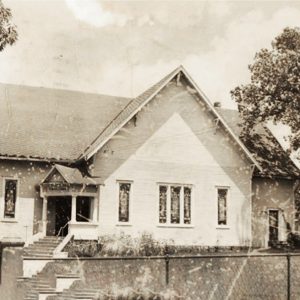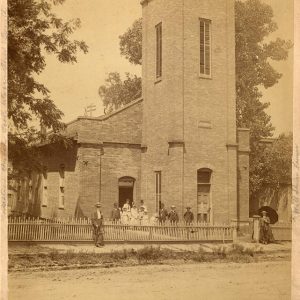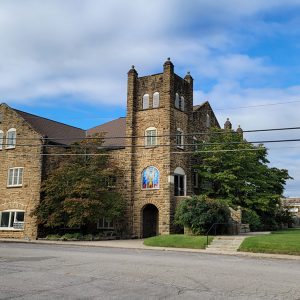calsfoundation@cals.org
Christian Church (Disciples of Christ)
The Christian movement called “Disciples” (among other names) came to Arkansas in the 1830s. Ministers who were initially associated with other denominations began work in the state, and then, as Disciples moved west, they were caught up in the wave of those leaving behind their former ties and becoming “Christians only.”
Disciples in the United States
The Christian Church (Disciples of Christ) is one of three denominations descending from the Stone-Campbell movement of the nineteenth century, which has its source in the Second Great Awakening—a period during which a number of Christian denominations underwent changes due to revivals and several new sects were created. Along with Churches of Christ and the Christian Churches/Churches of Christ, Disciples help make the “three streams” of the Stone-Campbell movement.
In 1801, Kentucky was part of the western frontier of the expanding United States. A Presbyterian minister named Barton Warren Stone (1772–1844) served two churches in Bourbon County and heard of several meetings nearby that were marked by large crowds and religious fervor. After traveling to experience a meeting for himself, Stone returned to his church at Cane Ridge, Kentucky, and organized what was to become the watershed meeting of this revival period in the fall of 1801. Disciples trace their origins to this meeting.
In 1804, Stone and several fellow Presbyterian ministers withdrew from the synod and formed a new church. They chose to be called “Christians.” Stone reminded his followers “we are not the only Christians, but we are Christians only.” An emphasis on New Testament doctrine, communion, and the unity of all persons of faith characterized this new church.
In the first decade of the nineteenth century, Thomas Campbell (1763–1854) and his son Alexander Campbell (1788–1866) emigrated from Scotland to the United States. Like Stone, they were Presbyterians. Setting up work in western Pennsylvania (in areas that now include West Virginia), the Campbells soon concluded that they, too, should withdraw from the Presbyterians. In 1809, Thomas Campbell issued a “Declaration and Address” setting out the tenets of this new movement, which they preferred to call “Disciples.” With a call for unity, the Disciples movement matched many doctrines proposed by Stone’s Christians and added the practice of weekly communion. Disciples were also known for espousing the ideals of rationalism, enlightenment, and education.
In 1832, the two churches formally merged and retained both identifications: Christians and Disciples. The movement grew rapidly prior to the Civil War, with the largest growth in the Midwest. Following the war, differences between churches in the North and South, as well as disparities between urban and rural churches, caused initial splinters in the group. By the time of the 1906 U.S. Census of Religious Bodies, “Disciples” and “Churches of Christ” were identified as two separate denominations.
Along with other denominations in the mid-nineteenth century, Disciples formed missionary societies for work both in the United States and overseas. Following World War I, an emphasis on cooperative work among various agencies of the Church took precedence. By the 1960s, many leaders were urging a more unified approach to Church structure, while others were urging a renewed emphasis on congregational polity. At the 1968 national meeting in Kansas City, Missouri, the Christian Church (Disciples of Christ) was formally organized. Those congregations that chose not to participate in the new structure are still called Christian Churches (sometimes independent Christians).
The Christian Church (Disciples of Christ) in the United States and Canada is headquartered in Indianapolis, Indiana, and is organized by congregations, regions, and national (general) ministries. While these three expressions of the Church agree to cooperate in various programs and services, the independence of each congregation is maintained. The General Assembly convenes every two years to carry out the business of the Church and elects a general board to conduct business between the assemblies. A general minister and president, elected by the General Assembly, serves a six-year term and is the legal officer of the corporation.
As a denomination of mainline Protestantism, the Christian Church (Disciples of Christ) emphasizes evangelism, social justice, racial/ethnic reconciliation, peace initiatives, and individual participation in faith and society. The Church has been at the forefront of the ecumenical movement since interfaith dialogue was organized in the first part of the twentieth century. Almost seventeen colleges and ten schools for theological education are affiliated with the Church, including Texas Christian University.
Disciples in Arkansas
Disciples’ work in Arkansas began in the 1830s (although some ministers who would ultimately join with the Disciples were working in the state a decade earlier under the authority of different denominations). In 1832, a congregation was formed in Little Rock (Pulaski County) following a speech by Benjamin Franklin Hall at a Temperance Society meeting. Elijah Kelley (1800–1884) established a church in the Stone-Campbell tradition in Antioch, now Delight (Pike County), in 1833. He later served as a delegate to the convention that formed the state of Arkansas.
Robert Graham of the Disciples of Christ opened an academy in Fayetteville (Washington County) in the fall of 1850 with twenty students. The following year, the school acquired the name Arkansas College. Under that name, on December 14, 1852, it became the first college chartered by the state of Arkansas to open. The school closed during the Civil War and never reopened, but it is regarded as the forerunner of the University of Arkansas (UA) in Fayetteville.
The Arkansas Christian Missionary Convention was organized in 1883 to coordinate the work of congregations, and the Arkansas Christian Woman’s Board of Missions was founded in 1886. By the end of the nineteenth century, congregations of Disciples were organized in fourteen separate districts and spread throughout the state. There were almost 150 Disciples preachers in Arkansas by 1897, although the majority were self-supporting and only worked in ministry part time.
As the twentieth century dawned, Disciples in Arkansas increased their emphasis on evangelism and worked to renew worship practices in congregations. The ministry of the state’s Christian Woman’s Board of Missions also became a more prominent player in the first decades of the new century. African American Disciples congregations had grown to the extent that they held their own state convention for women’s ministries in 1911.
Interest increased for spreading Disciples’ news specifically for Arkansas congregations. John S. Zeran (1864–1938), pastor of the Bentonville (Benton County) congregation, launched the Arkansas Christian in 1915. The paper joined the ranks of many state denominational newspapers around the nation.
Like many Protestant denominations, Disciples redoubled their efforts in evangelism following World War I. A campaign called “Each One Win One” promoted by the American Christian Missionary Society swept through the United States and Canada in 1919 and 1920. Twenty-three Arkansas congregations participated in the campaign, including Berryville (Carroll County), Pine Bluff (Jefferson County), and Texarkana (Miller County).
Arkansas congregations held fast throughout the 1920s and 1930s. Following involvement in the national “Crusade for a Christian World,” by the end of the 1940s Arkansas Disciples were experiencing the kind of hope for their future that had been lacking during the war years. The state convention of 1948 held in Fayetteville was widely attended, and a new constitution was approved that united the work of agencies like the Arkansas Christian Missionary Society and the Board of Christian Education. Also, a resolution was passed to begin ministry among the students of UA in Fayetteville.
The last half of the twentieth century brought continuing expansion for Disciples’ work in Arkansas. While a movement was under way nationally for a more defined structure and greater unity among Disciples, Arkansas led the way in 1966 by merging the work of African-American and white congregations throughout the state (the national merger of these groups came in 1969). By the 1980s, there were seventy-five congregations in the state. While most of them had fewer than 100 members (similar to the majority of congregations of all kinds throughout the United States), over a dozen had up to 500 active members.
In 2002, seeking to consolidate ministry and operate more efficiently, Arkansas became part of the Great River Region of the Christian Church (Disciples of Christ). The region also includes churches in Louisiana and Mississippi. The regional office is located in Little Rock. Statewide, there are over fifty congregations, with a total of approximately 11,475 members. The regional staff provides resources to churches, including educational opportunities, summer camps, and mission trips.
For additional information:
Disciples of Christ Historical Society. Nashville, Tennessee. http://www.discipleshistory.org/ (accessed January 25, 2023).
Foster, Douglas, et al., eds. The Encyclopedia of the Stone-Campbell Movement. Grand Rapids, MI: Eerdmans Publishing Co., 2004.
Great River Region of the Christian Church (Disciples of Christ). http://www.grrcc.org (accessed January 25, 2023).
McAllister, Lester G. Arkansas Disciples: A History of the Christian Church (Disciples of Christ) in Arkansas. Richmond, VA: Christian Church, Disciples of Christ, 1984.
Glenn Thomas Carson
Disciples of Christ Historical Society







Comments
No comments on this entry yet.